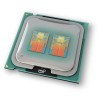- Qualcomm Launches Snapdragon 4 Gen 2 Mobile Platform
- AMD Launches Ryzen PRO 7000 Series Mobile & Desktop Platform
- Intel Launches Sleek Single-Slot Arc Pro A60 Workstation Graphics Card
- NVIDIA Announces Latest Ada Lovelace Additions: GeForce RTX 4060 Ti & RTX 4060
- Maxon Redshift With AMD Radeon GPU Rendering Support Now Available
Q9400S & Q8200S: Intel’s 65W Quad-Cores

The benefits of a low-TDP processor are obvious, but a usual downside is also obvious: low clock speeds. Intel’s changing that thinking with their Core 2 Quad “S” series, which includes the Q9550S, Q9400S and also the Q8200S. Compared to their non-“S” variants, they draw less power and run cooler, all while retaining the performance they’ve become known for.
Page 8 – System: Sandra Memory, Multi-Core Efficiency
Generally speaking, the faster the processor, the higher the system-wide bandwidth and the lower the latency. As is always the case, faster is better when it comes to processors, as we’ll see below. But with Core i7, the game changes up a bit.
Whereas previous memory controllers utilized a dual-channel operation, Intel threw that out the window to introduce triple-channel, which we talked a lot about at August’s IDF. Further, since Intel integrates the IMC onto the die of the new CPUs, benefits are going to be seen all-around.
Before jumping into the results, we already had an idea of what to expect, and just as we did, the results seen are nothing short of staggering.


Where bandwidth is concerned, absolutely no increases are seen on the Core 2 platform when sticking to the same front-side bus. That only changes with Core i7, as the incredible results at the top of the graph shows. Since both the Q9400’s and the Q8200 utilize a 1333MHz FSB, the bandwidth hovers around 7,500 for both the Int and Float. Latencies for the most part are the same way, although they don’t average out as well as the bandwidth does, and each run of the benchmark would be ±3 – 5.
Sandra 2009 Multi-Core Efficiency
How fast can one core swap data with another? It might not seem that important, but it definitely is if you are dealing with a true multi-threaded application. The faster data can be swapped around, the faster it’s going to be finished, so overall, inter-core speeds are important in every regard.
Even without looking at the data, we know that Core i7 is going to excel here, for a few different reasons. The main is the fact that this is Intel’s first native Quad-Core. Rather than have two Dual-Core dies placed beside each other, i7 was built to place four cores together, so that in itself improves things. Past that, the ultra-fast QPI bus likely also has something to do with speed increases.

This Sandra test gives pretty expected results. The faster the CPU, the lower the latency and faster the core negotiations. This is one area where i7 excels, thanks in part to its ultra-fast QPI bus.
Support our efforts! With ad revenue at an all-time low for written websites, we're relying more than ever on reader support to help us continue putting so much effort into this type of content. You can support us by becoming a Patron, or by using our Amazon shopping affiliate links listed through our articles. Thanks for your support!





